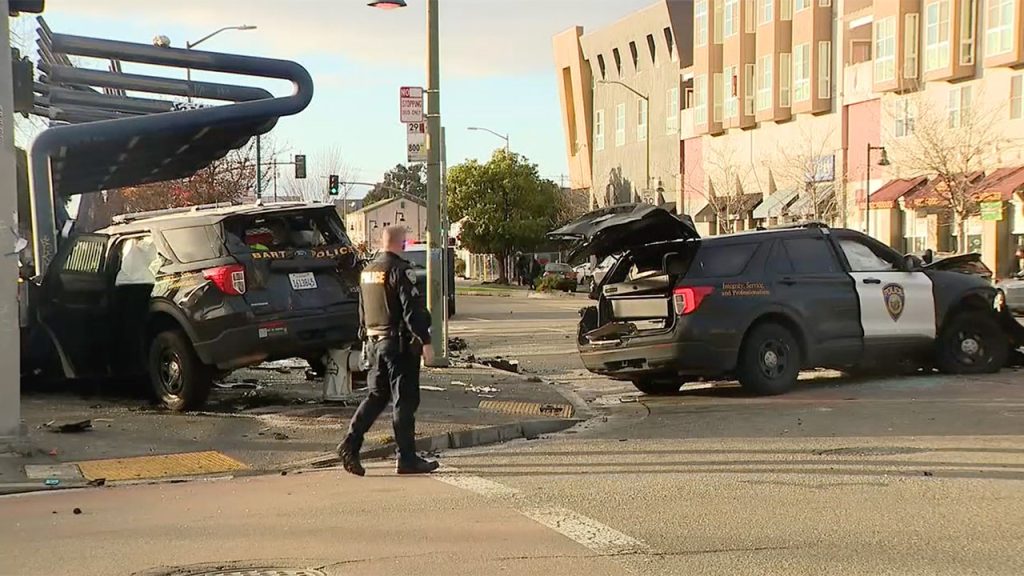A multi-vehicle collision involving two Bay Area Rapid Transit (BART) police vehicles shook the 700 block of Mandela Parkway in Oakland, California, on a Saturday afternoon, leaving several individuals injured and prompting a swift response from local authorities. The crash, which occurred near the West Oakland train station around 2:45 p.m. local time, transformed a typically bustling area into a scene of wreckage, with shattered glass, open car doors, and scattered debris marking the point of impact. The Oakland Police Department (OPD) immediately took charge of the situation, coordinating with paramedics to transport the injured to nearby hospitals for treatment. While the exact number and severity of the injuries remain undisclosed, the collision underscored the inherent risks associated with law enforcement activities, particularly those involving high-speed pursuits or emergency responses.
The aftermath of the collision brought a wave of investigative activity as law enforcement officials sought to piece together the events leading up to the crash. The OPD launched a thorough investigation, meticulously examining the scene, interviewing witnesses, and analyzing any available footage to determine the cause of the incident. While the investigation is ongoing, authorities have not ruled out the possibility of contributing factors such as alcohol or drug impairment. The involvement of two BART police vehicles raises questions about the circumstances surrounding their presence at the location and whether any specific operational procedures were being followed at the time of the crash. The investigation will undoubtedly delve into these aspects, aiming to provide a comprehensive understanding of the events that unfolded.
The incident also brought to light the broader challenges faced by law enforcement agencies in Oakland, a city grappling with high crime rates and resource constraints. The crash occurred amidst ongoing discussions about police staffing levels, response times, and the overall effectiveness of crime-fighting strategies. Just months prior to the collision, the president of the Oakland Police Officer’s Association (OPOA), Huy Nguyen, had publicly criticized then-Mayor Sheng Thao for her approach to crime reduction, alleging a lack of support for law enforcement and a failure to address the concerns of residents who felt unsafe in their own neighborhoods. Nguyen’s comments reflected a growing frustration within the police force and a sense of urgency to improve public safety in the city.
Further complicating the narrative surrounding the Oakland Police Department was an ongoing controversy regarding crime reporting practices. In July, just weeks before the multi-vehicle crash, the OPD faced scrutiny for allegedly under-reporting crime statistics, claiming a 33% reduction in crime that was later disputed. This discrepancy between reported figures and the perceived reality on the ground further strained the relationship between the police department and the community it serves. The alleged under-reporting, which was initially touted by Mayor Thao as a sign of progress, raised concerns about transparency and accountability within the OPD, further eroding public trust and fueling skepticism about the effectiveness of crime-fighting initiatives.
The multi-vehicle crash involving BART police vehicles serves as a stark reminder of the complex and often challenging landscape of law enforcement in Oakland. The incident highlights the inherent risks faced by officers in the line of duty, the importance of thorough investigations to determine the cause of such incidents, and the ongoing need for open dialogue and collaboration between law enforcement agencies and the communities they serve. The crash also underscores the broader context of crime and public safety in Oakland, a city struggling to address persistent challenges while simultaneously navigating internal debates about policing strategies and resource allocation. The investigation into the crash will undoubtedly provide valuable insights into the specific events that unfolded on that Saturday afternoon, but it also serves as a catalyst for broader discussions about public safety, police accountability, and the future of law enforcement in Oakland.
The incident also underscores the importance of collaboration and communication between different law enforcement agencies operating within the same jurisdiction. The involvement of both BART police and the OPD necessitates a coordinated investigative effort to ensure a comprehensive and unbiased assessment of the events. Furthermore, the crash serves as a reminder of the need for ongoing training and professional development within law enforcement to enhance safety protocols and minimize the risk of such incidents in the future. The lessons learned from this incident will hopefully contribute to improved practices and policies that prioritize the safety of both officers and the public they serve.

